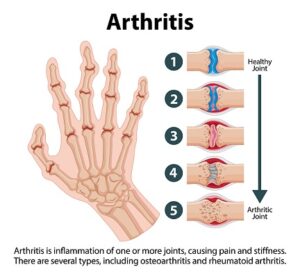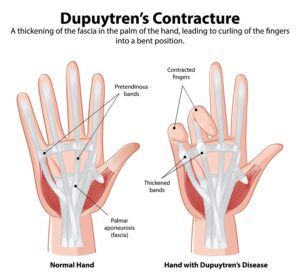Common Conditions
We are currently updating this section.
Arthritis
Visit the following websites:

Illustrated infographic depicting stages of arthritis in human hand
Carpal Tunnel
What is it?
Carpal tunnel syndrome is pressure on the median nerve in your wrist.
What causes Carpal Tunnel Syndrome?
You are more at risk if you are:
– overweight
– pregnant
– do work or hobbies where you repeatedly bend your wrist or grip hard
– have another illness, like arthritis or diabetes
– have a family member with CTS
– have previously injured your wrist
You may have some of the following signs and symptoms:
- Pins and needles/ tingling sensations in the thumb, index and middle fingers.
- An ache or pain in your fingers or hand, sometimes going up the arm.
- Numbness in the thumb, fingers or palm.
- A weak thumb or difficulty gripping or tendency to drop things.
Treatment: CTS sometimes gets better by itself in a few months.
- Splint: Wear a wrist splint to keep your wrist straight. It can be bought from pharmacies or online. The splint should be worn at night, while you sleep, for at least 4 weeks.
- Activity: Stop or cut down on activities that may be causing you to frequently bend your wrist or grip hard for extended periods of time (e.g. using vibrating tools for work or playing an instrument).
- Hand therapy: if your symptoms are not improving with above advice, you may benefit from seeing a hand therapist for splinting, exercises and advice.
- Injection to the wrist, is a treatment option, if other treatment has not helped.
- Surgery: if your symptoms are not getting better with other treatments, you may need surgery. The surgery is usually done as a day case. Severe CTS may not completely go away after surgery, but surgery may prevent it from getting worse.
Dupuytren's
Dupuytren disease is the most common crippling hand condition that people have never heard of. It affects at least ten million Americans, making their fingers permanently bent, sometimes severely. Why isn’t it more commonly known? Dupuytren contracture makes the fingers bent as if relaxed, not obvious unless the person tries to open their hand. It progresses slowly, usually doesn’t hurt, and mostly affects seniors. It’s often mistaken for arthritis or tendinitis. Visit: https://dupuytrens.org/

Comparison of normal hand and affected hand
Trigger Finger
A trigger finger is a very common and treatable problem. It can occur in both fingers and the thumbs, which have tendons that help them to bend. The flexor tendons that bend the fingers have a lining on the outside. This lining is called tenosynovium. The tendon and lining are covered by a series of thick, soft tissue called pulleys. The tendon and its lining are designed to glide through the pulleys without friction. The pulleys are similar to how a line is held on a fishing rod.
A trigger finger, sometimes referred to as a trigger thumb or stenosing tenosynovitis, can occur if one of three things happen: 1. The tendon enlarges (does not fit through pulley well); 2. The lining increases in thickness (does not fit through pulley well); 3. the pulley becomes thicker (the opening for the tendon gets smaller). The finger tendon and pulley system is designed to have the exact right sizes of each structure. The change in size of any of the important finger structures can cause problems. If the tendon becomes tight within the pulley, the lining gets squeezed and reacts with thickening. The bigger lining then produces more fluid. And the higher volume of fluid increases pressure. The undersurface of the pulley can also change and thicken. This thicker pulley causes friction on the moving tendon. This makes it difficult for the tendon to move back and forth.

